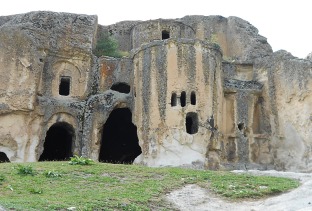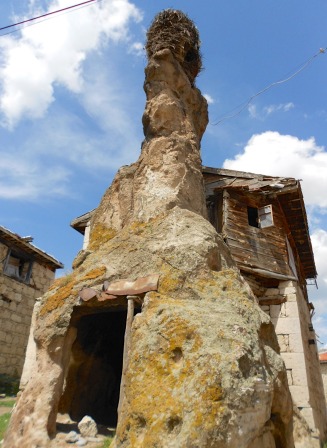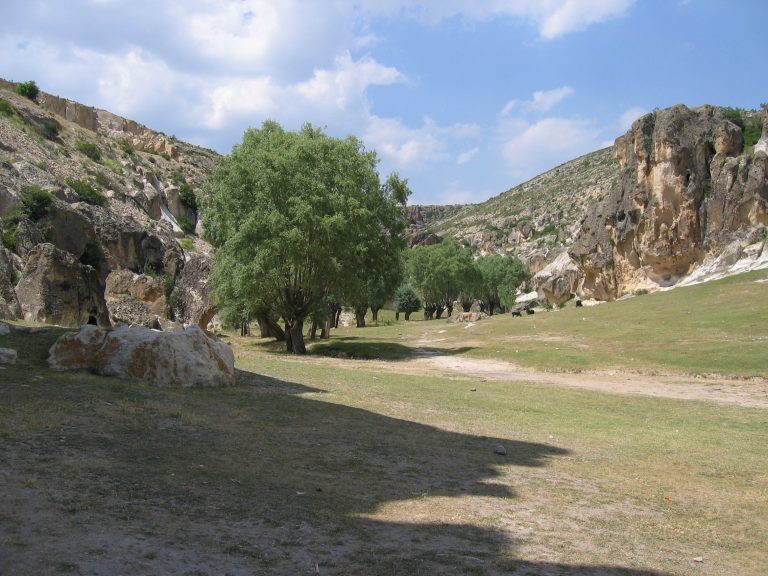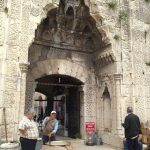Turkey’s first Insta-village? Population: 2,000
Market day: Friday
Eleven km northeast of the spa at Gazlıgöl, Ayazini is like a smaller and much less well-known version of the Cappadocia tourism honeypots.
There’s the same mix of attractions: a wild, romantic landscape with gorges and crazy rock formations, some even called peribacalar (fairy chimneys) like their Cappadocian counterparts; stone houses resting against the rock; and churches and tombs cut right into it.
What there wasn’t until recently was the crowding that can sometimes detract from the Cappadocian experience although all that may be about to change.
The attractions of Ayazini are obvious as soon as the bus rounds the bend that leads to the village and you see, on the left, a long stretch of rock with, almost immediately, a church built partly against and partly into the rock, complete with an external dome and an apse cut with what look very like Romanesque windows.
Inside, all is soot-blackened, but the spaces are enormous and you can still see how, just as in Cappadocia, the features of a built church were reproduced by careful hollowing out of the rock.
From there on the necropolis of Metropolis trickles along the road. Most of the tombs are mere niches in the rock but some are far more impressive – just before the rock opens out into a field, for example, there is a distant tomb with small lions carved above it. 
The field provides access to a gorge that follows a small stream for 2km until it opens out again amid poppy fields with a huge chunk of rock looming on the landscape.
Off to the right is another huge rock called Avdalez Kalesi. “Kale” may mean “castle” in Turkish but this is a castle only in the Uçhisar/Ortahisar (Cappadocia) sense in that it is a vast rock hollowed out with rooms accessed via a treacherous stone staircase.
You can walk back through the gorge and then keep following the wall of rock all the way past the necropolis to the village. If you do this, you will see the amazing sight of modern gravestones filling a cemetery right in front of a tomb dating back some 2000 years, proof yet again that once a site has been dubbed “sacred” it often remains so over time despite cultural and religious changes.
Just before the village itself there are some extraordinary tombs with triangular pediments carved with rose-like motifs.
Alternatively, from Avdalez you can follow the rural road that runs above another gorge to the back of the village. At the far end of the gorge a few fairy chimneys are lined up as at Çavuşin in Cappadocia. This walk is almost as enjoyable as the one through the gorge – and a good deal less muddy in spring!
 The shock hits when the reach what was ten years ago the old, semi-abandoned part of Ayazini. This was full of old stone houses with fine wooden doors, the most impressive attached to a fairy chimney with a huge stork’s nest on top. No more. All the houses have been meticulously repaired/rebuilt to suit Instagrammers’ demand for beauty. Sure enough, in the gaps in between them can be found an assortment of picture-perfect swings, fake flowers and inverted umbrellas. Every shop is geared to tourist needs. You’ll love it or hate it. It’s hard to be neutral.
The shock hits when the reach what was ten years ago the old, semi-abandoned part of Ayazini. This was full of old stone houses with fine wooden doors, the most impressive attached to a fairy chimney with a huge stork’s nest on top. No more. All the houses have been meticulously repaired/rebuilt to suit Instagrammers’ demand for beauty. Sure enough, in the gaps in between them can be found an assortment of picture-perfect swings, fake flowers and inverted umbrellas. Every shop is geared to tourist needs. You’ll love it or hate it. It’s hard to be neutral.
Sleeping
You could base yourself in Afyon or in Gazlıgöl if spa baths are your thing. Otherwise:
Ayazini Konaklama. Tel: 0545-891 3575
Inn Hotel. Tel 0546-663 0303
Transport info
A timetabled bus service runs from the Köy Garaj in Afyon; pick it up at the Tren İstasyon Kavşağı (junction) to avoid the shlep out to the remote local bus terminal. Check return times carefully – I found plenty to occupy the three hours between the two services I used.
Ayazini sits on the newly waymarked Frig Yolu (Phrygian Way) and the route through the gorge is marked with red and white flashes. It’s 10km from Ayazini to the Göynüş Vadisi, home to many Phrygian monuments.  Avdalez Kalesi
Avdalez Kalesi

